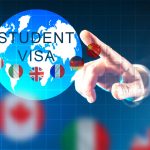

1. Understand the Basics of a Student Visa
Every country has its own set of rules and requirements for student visas. While the core elements are similar, nuances can make a big difference.
- United Kingdom (UK): The UK student visa is called the Student Route (Tier 4). Proof of sufficient funds and an acceptance letter from a UK-based institution are essential.
- United States (USA): The F-1 visa is for full-time students. You’ll need an I-20 form from your school to apply.
- Ireland: Known for its friendly student policies, Ireland requires non-EU students to have a valid acceptance letter and health insurance.
- Canada: The Study Permit is your key. Proof of funds and a letter of acceptance are vital.
- Australia: The Subclass 500 visa mandates proof of funds, English proficiency, and enrollment in an Australian institution.
Make sure you research the specific requirements of your chosen destination thoroughly before proceeding.
2. Start Early: Time is Your Best Friend
The visa process can take weeks or even months. Start as soon as you receive your acceptance letter. Many students face delays due to last-minute applications or incomplete documentation.
- Gather your documents early: Passports, acceptance letters, financial proof, English proficiency scores, and academic records.
- Book your visa appointment: Slots can fill up quickly, especially during peak times like June to August.
3. Prepare Financial Proof Thoughtfully
Most countries require proof that you can cover your tuition fees and living expenses. Here's how to prepare:
- Bank statements: Ensure your statements reflect sufficient funds for the required period.
- Scholarships: Provide official letters detailing your scholarship amount.
- Sponsors: If someone is sponsoring you, include their financial documents and a sponsorship letter.
Inadequate or questionable financial proof is one of the main reasons for visa rejections, so be meticulous.
4. Master the Application Process
Filling out a visa application might seem straightforward, but attention to detail is critical.
- Double-check your information: A minor error can delay the process.
- Follow country-specific instructions: For instance, the USA requires completing the DS-160 form online, while Canada has a dedicated portal for the Study Permit.
- Pay the fees promptly: Missing this step could halt your application.
5. Nail the Visa Interview
For countries like the USA, a visa interview is mandatory. Here’s how to prepare:
- Understand your course and goals: Be ready to explain why you chose this course and institution.
- Know your financial details: Be confident about who is funding your education.
- Stay calm and confident: Nervousness can affect your answers. Practice mock interviews to ease anxiety.
6. English Proficiency is Key
For most destinations, demonstrating English proficiency is mandatory. Popular tests include IELTS, TOEFL, and PTE.
- Meet the minimum score: Each country and institution has specific requirements.
- Prepare well in advance: Take time to practice reading, writing, listening, and speaking skills.
7. Focus on Genuine Intent
Immigration officers assess whether you are genuinely planning to study or have other motives. Prove your intent through:
- A clear Statement of Purpose (SOP): Explain your study goals, why you chose the specific country, and how it aligns with your career.
- Strong ties to your home country: Highlight family, assets, or career prospects that show you intend to return after completing your studies.
8. Health and Insurance Requirements
Many countries require medical examinations and health insurance.
- Medical checks: Schedule your health screening early to avoid delays.
- Insurance: Some countries, like Australia and Ireland, mandate specific health insurance for students.
9. Avoid Common Mistakes
Small errors can lead to visa rejection. Watch out for:
- Incomplete forms: Double-check all sections.
- Missing deadlines: Late applications are often rejected outright.
- Misrepresentation: Never provide false information. If caught, you may face a ban from entering the country.
10. Seek Professional Guidance
If the process feels overwhelming, don’t hesitate to seek expert advice. Agencies specializing in student visas can guide you through the documentation, application, and interview stages.
11. Stay Updated on Immigration Policies
Immigration rules change frequently. For example:
- Post-study work opportunities: The UK now offers a two-year Graduate Route visa for international students.
- Extensions: Canada and Australia allow you to extend your visa for further studies or work.
Keeping up-to-date ensures you make informed decisions throughout your application journey.
12. Be Patient and Positive
Visa processes can be stressful. Some applications may take longer due to unforeseen circumstances. Stay patient, follow up when necessary, and keep a positive outlook.
In a Nutshell
Securing a student visa is your ticket to a world of opportunities, but it requires careful planning and execution. By following these tips, you can navigate the process confidently and increase your chances of success.
Your dream of studying in the UK, USA, Ireland, Canada, or Australia is closer than you think. Take the first step today, and soon you’ll be walking the halls of your dream university, ready to create a brighter future!
- By admin




